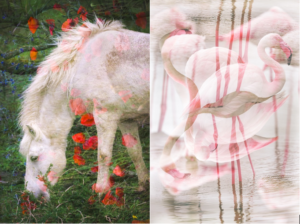In the heart of the Camargue, a region known for its wild horses, vibrant birdlife, and timeless landscapes, I found myself drawn to explore photography beyond the conventional. The Camargue has been a muse for countless artists, including the likes of Vincent van Gogh, whose works captured the essence of this unique region. But as I wandered through its marshlands and historic towns, I felt a pull to create something that hadn’t been seen before—a representation that went beyond the surface, delving into the surreal and the dreamlike. This is where the journey of my double exposures began.
Blurring the Lines Between Reality and the Dreamlike The decision to experiment with double exposures was not merely a technical choice; it was a way to forge a path less traveled. In a region so frequently photographed, I sought to transform familiar scenes into something new and intriguing. By blending two distinct images, I aimed to create a space where the ordinary became extraordinary, where reality blurred into the surreal. These images invite us to linger in that confusion, much like stepping into a forbidden space—unfamiliar, yet captivating.

For instance, in “Dali’s Flamingo,” I found inspiration in Salvador Dalí’s surrealistic visions. The elongated legs of the flamingo mirrored the dreamlike creatures Dalí often depicted. The reflection of these flamingos in the water allowed me to stretch the boundaries of reality, creating an image that feels both familiar and otherworldly.
Navigating Challenges and Embracing the Surreal This collection came to life in the face of unexpected challenges. The weather was often uncooperative, with days of rain that threatened to dampen the creative process. Yet, these obstacles became the very catalyst for innovation. As I navigated through the stormy days, my creative boundaries stretched, transforming familiar scenes into something fresh and intriguing.
Take “Night-Mare” for example—a piece that explores the darker, more unsettling side of this landscape. The bull, traditionally a symbol of strength and dominance, becomes a creature of dread in the horse’s nightmare. The double exposure technique allowed me to capture this disorienting vision, where the bull’s horns frame the image, creating a sense of entrapment. It’s a reflection of the fear and fascination that lie just beneath the surface, both in nature and within ourselves.
Personal Reflection These double exposures are more than just photographs; they represent a pivotal moment in my artistic journey. As I stood in the rain, wiping my camera and searching for new ways to see the world around me, I discovered that the challenges I faced were pushing me to grow. The process of creating these images was transformative, leading me to see the familiar in a new light.
In “Petals and Mane,” the blending of a Camargue horse with vibrant red poppies became a metaphor for the transience and resilience of life in this region. The image evokes a sense of nostalgia and timelessness, capturing the essence of the Camargue in a way that feels both painterly and profound.
For me, these images are not just about the Camargue—they are about the artistic journey itself. They reflect the willingness to venture into the unknown, to embrace uncertainty, and to find beauty in the unexpected. It’s a reminder that sometimes the most profound art is born from the challenges we face, from the moments when we allow ourselves to let go of control and simply create.
“Forging New Paths: The Creative Journey Behind Double Exposures in the Camargue” is a reflection of my desire to capture the essence of this region in a way that goes beyond the obvious. It’s about stepping into a realm where the familiar is transformed, where reality and dream converge, and where art becomes a journey of discovery. Through these images, I hope to invite you into this space of wonder and intrigue, to see the Camargue not just as it is, but as it could be in the realm of the imagination.


